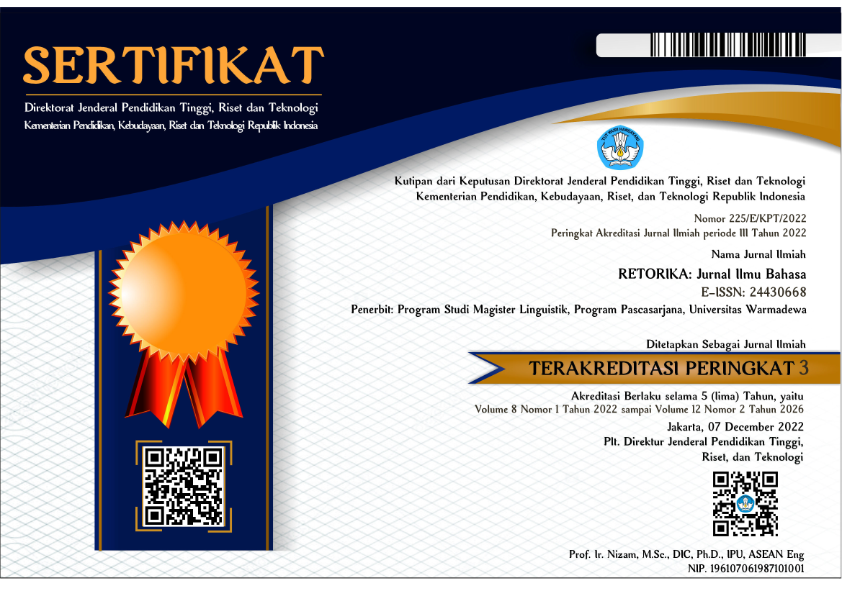Codes Switching and Codes Mixing of Sellers and Buyers in Traditional Markets: Case Study of Market Kampong Asembagus Situbondo
Abstract
The process of buying and selling communication in Asembagus Traditional Market often experiences language contact because the sellers and buyers come from several ethnicities who have different languages ​​and cultures. This study aims to determine the form of code-switching and code-mixing speech between sellers and buyers in Asembagus Market, Situbondo. The method used in data collection is the engaging listening method with the technique of recording, taking notes, interviews and descriptive qualitative approaches. The results showed that there were 12 forms of code switching speech and 10 speech code mixtures between sellers and buyers at Asembagus Situbondo Market Kampong. Master more than one language and speakers try to build an atmosphere of speech with mixed languages, while the functions of code-switching and code-mixing speech used by sellers and buyers at Pasar Kampong are to adjust the social context and to smooth and build the communication process of bargaining, transactions, and interactions.
References
Chaer, A & Agustina, L. (2004) Sociolinguistics Early Introduction: Jakarta Rineka Cipta.
Hymes, D. (1973) Foundations in Sociolinguistics: An Ethnographic Approach. Mt. Hood National Forest.
Jendra, M. (2001) Sociolinguistics. Yogyakarta: Graha Science.
Kridalaksana, H. (2008) Linguistic Dictionary. Jakarta: PT Gramedia Pustaka Utama.
Maryani, R. (2011). Analysis of Code Mixing in Novels When Love is Praised by Habiburrahman El Shirazy. Thesis: Faculty of Tarbiyah and Teacher Training. Jakarta: Syarif Hidayatullah State Islamic University.
Moleong, L.J. (2000). Qualitative Research Methods. Bandung: PT Remaja Rosdakarya.
Mujiono. (2013). Analysis of Code Switching in Teaching English in the English Language Education Study Program at the University. (Case Studies at Um, Umm, Unikama, and Unesa). Dissertation: Postgraduate Program, Sebelas Maret University, Surakarta.
Nababan, P.W.J. (1984) Sociolinguistics: An Introduction. Jakarta: Gramedia.
Poplack, S. (1980). Sociolinguistics: An International handbook of the Science of Language and Society.
Purnamawati, A. (2010). Code Mixing and Code Switching for sellers and buyers at Pasar Johar Semarang. Essay. Indonesian Language and Literature Education Study Program Faculty of Language and Arts Education: IKIP PGRI Semarang.
Rahardi, K. (2001). Sociolinguistics, Code and Code Switching. Yogyakarta: Student Library.
Rohmani, S, Fuady, A & Anindyarini, A. (2013) Analysis of Code switching and Code Mixing in Novel Negeri 5 Menara by Ahmad Fuadi. BASASTRA: Journal of Language Research, Indonesian Literature and Teaching Volume 2 Number 1.
Salikin, H. (2017). Researchers and Qualitative Research. An initial understanding. RI National Library. The Catalog In Issue (KDT).
Siswantoro. (2010). Literary Research Methods, Poetry Structure Analysis. Yogyakarta: Student Library.
Sumarsono and Paina, P. (2004). Sociolinguistics. Yogyakarta: Sabda.
Suwito. (1985). Early Introductory Sociolinguistics. Surakarta: Henry offset.
Wardaugh, R. (1992). An Introduction to Sociolinguistics. Oxford: Basil Black Well.
Wulandari, R. Marmanto, S and Sumarlan. (2016) Code switching in Novel Heaven’s Unmoved Dialogue by Asma Nadia: Journal of Linguistics, Vol. 1 Number 2.
Copyright (c) 2021 RETORIKA: Jurnal Ilmu Bahasa

This work is licensed under a Creative Commons Attribution-ShareAlike 4.0 International License.
This journal provides immediate open access to its content on the principle that making research freely available to the public supports a greater global exchange of knowledge.
All articles published Open Access will be immediately and permanently free for everyone to read and download. We are continuously working with our author communities to select the best choice of license options, currently being defined for this journal as follows: Creative Commons-Non Ceomercial-Attribution-ShareAlike (CC BY-NC-SA)
 Abstract viewed = 324 times
Abstract viewed = 324 times
 PDF downloaded = 293 times
PDF downloaded = 293 times

2.png)














